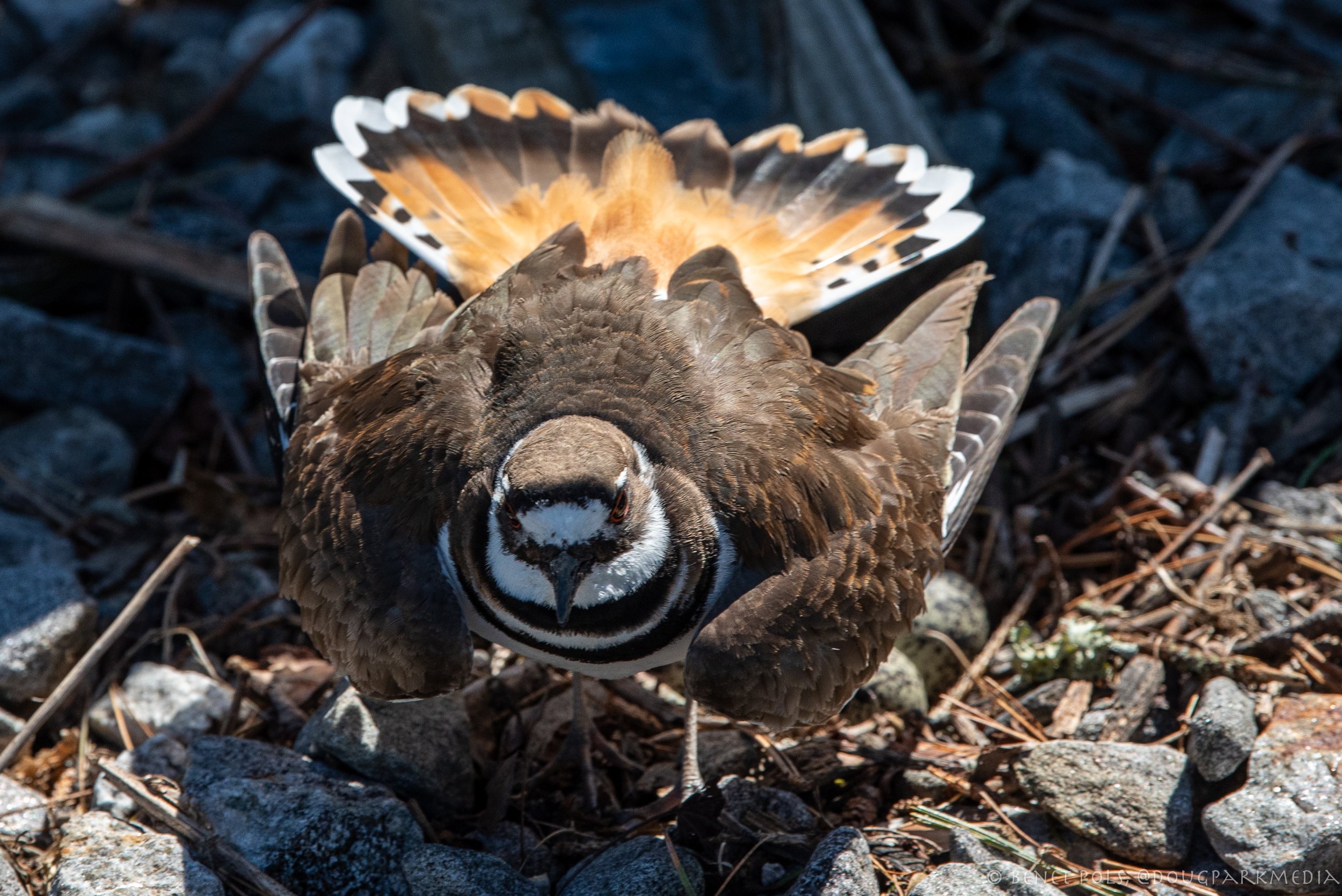Walking backwards through a little pine copse near the high school tennis courts I heard an agitated, strident, clear teeee di di repeated. It was quickly followed by a high, rapid trill ttttttt. This bird was nervous.
Oddly if it had just internalized its agitation, as I do, I never would have known it was there. I heard it long before I saw it and never would have been looking for it, or anything, where it sat guarding its little nest and four eggs. It was well camouflaged so on this pass I did not locate the bird at all. I resumed looking through my camera and moving around this copse doing some test shots in preparation for team photos. Ten minutes later some other movement sparked another outrage from what, once I saw it, I knew was a Killdeer.
Sibley tells us, “Semi palmated plovers commonly use a low accelerating churtle call that is usually accompanied by partially drooped wings, raised back feathers, lowered head, and a fanned tail. This combination of vocalization and posture is aggressive in nature; the birds use it in defending breeding territories and nonbreeding feeding territories.” I did not need this particular lesson. Once you’ve heard the churtle you know where you stand, but I was glad to learn that a Killdeer is a Plover.
Anyone who has been to Sewall Beach knows the plovers are worth the walk.
On the first day I encountered this Killdeer it did not perform its signature dance of the false broken wing but something about its nest location told me I was seeing a Killdeer. With my camera already around my neck it was pretty easy to grab a couple of shots of the agitated parent before moving away.
The nest itself was in the heavy gravel of a drainage basin beneath the only small set of bleachers near the tennis courts. With a match set to take place in an hour spectators would be tromping through the area with some regularity, no doubt wanting to use the bleachers. Not good if you are an agitated, nervous, incubating Killdeer.
The Coach said he would ask people not to use the bleachers.
It is a peculiar thing in the Killdeer. On one hand it has developed a sophisticated behavioral ruse to draw predators away from its nest. It is a talented actor. Sibley refers to it as a distraction display but it seems more of a distraction bit. The adult Killdeer moves away from the nest while dragging its wing as if injured; it moves in fits and starts giving the predator the sense that one more try might net a tasty, if agitated, morsel. When the predator has been led far enough away from the nest, the adult will fly off.
On the other hand, the bird seems to build its nest in the most vulnerable of spots. In general, “Plover nests can be located almost anywhere in the ground—-from the tops of tussocks on open tundra, to gravel bars in braided streams, to furrows in plowed fields and dune hollows on sandy beaches. The nests are typically shallow scrapes….lined with a few pebbles, shell fragments, grass strips, bits of lichen or moss.” The Killdeer (C. Vociferus) particularly will “nest in habitats ranging from. . . .plowed fields to golf courses, and gravel rooftops.”
Perhaps if the Killdeer would devote some of the time it spends rehearsing its bit to thinking about better nesting locations we would all be more familiar with the species.
After getting my photos I left area to shoot a couple other teams elsewhere on the school grounds. Returning after the tennis match I found that the activity surrounding it had indeed driven the adult off, a least temporarily.
Possibly this particular family could not find a rooftop to its liking so chose a patch of good gravel, shaded by the bleachers, but sandwiched between high school athletics fields and the bus loop. No doubt there was no tennis or other high school activity on the day this family started nesting.
I learned that all plovers species show strong site fidelity. Many species will replace sets of eggs that are lost, and the Charadrius plovers, such as the Killdeer, which nest at temperate latitudes often produce a second brood. As ground nesting shorebirds experience high rates of nest predation, a possible explanation of their small clutch size—usually no more than four, which is the number I could see in my photos—is that small clutches are less vulnerable to predators, take less time to produce, and are therefore easier to replace if lost.
Another important pice of information is that the incubation period is long. Twenty-one to thirty days in North American species. And that Killdeer are in decline, mainly as a result of changes to human agricultural habits.
A Thursday night email to a high school biology teacher alerted the school to the birds’ presence. Given the question of site fidelity it seemed possible that their eviction was temporary. On Saturday morning when I returned to shoot a match against another top rated team there were plenty of spectators and lots of commotion but no one was sitting on the bleachers which had been encircled in caution tape.
The Killdeer was there too, sitting on its nest, difficult to spot unless you knew where it was. The bird had decided that this large number of noisy humans were focused on something aside from its nest. Returning later in the afternoon with more stakes to build out and solidify the tape barrier, I was treated to brief performance of the Killdeer’s distraction bit.
(For the less youthful readers Jack Antonoff has a band called Bleachers)




